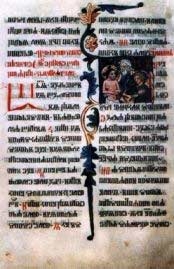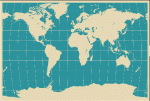Web catalog
Most read
Most read last 7 days
Most Discussed
Top rated
Statistics
- Total registered users: 10027
- Total articles: 23656
- Total comments: 2087
- Last entry: Kebo presenting evidence that Izetbegovic brought mujahideen to Bosnia
- Last update: 11.01.2019. 23:44
1100 to 1500 Church Slavonic literature, dialectal differentiation and vernacular literacy Cyrillic and Latin Script
Written 03.12.2009. 11:16
 However, the luxurious and ornate representative texts of Croatian Church Slavonic belong to the later era when they coexisted with the Croatian vernacular literature. The most notable are the Missal of Duke Novak from Lika region in northwestern Croatia (1368), Evangel from Reims (1395, named after the town of its final destination), Missal of Duke Hrvoje from Bosnia and Split in Dalmatia (1404) and the first printed book in Croatian language (1483). Great migrations following the Ottoman invasion, the growing influence of Croatian or Bosnian Cyrillic and, finally, the prevalence of Latin script -both as the medium of western literature (sacral and secular) and the dominant, although not standardized Croatian script- all these factors spelled the doom of Glagolitic literacy. Croatian Glagolitic scriptory tradition died out, mainly, in the 17th century.
However, the luxurious and ornate representative texts of Croatian Church Slavonic belong to the later era when they coexisted with the Croatian vernacular literature. The most notable are the Missal of Duke Novak from Lika region in northwestern Croatia (1368), Evangel from Reims (1395, named after the town of its final destination), Missal of Duke Hrvoje from Bosnia and Split in Dalmatia (1404) and the first printed book in Croatian language (1483). Great migrations following the Ottoman invasion, the growing influence of Croatian or Bosnian Cyrillic and, finally, the prevalence of Latin script -both as the medium of western literature (sacral and secular) and the dominant, although not standardized Croatian script- all these factors spelled the doom of Glagolitic literacy. Croatian Glagolitic scriptory tradition died out, mainly, in the 17th century. http://www.finns-books.com/croatico.htm
Missale Hervoiae ducis Spalatensis Croatico-Glagoliticum
http://www.croatianhistory.net/etf/novi.html
Croatian Glagolitic Manuscripts held outside of Croatia
12th-15th centuries: the period of dialectal differentiation. Croatian dialects are, roughly, divided in three groups named after the dialectal word for interrogatory pronoun which is in Latin «quid» or in English «what»: ča-Čakavian (chakavian), što-Štokavian (shtokavian) and kaj-Kajkavian (kaykavian). These dialects and their subdialects have undergone further changes in next 5 centuries, but the central characteristics were virtually fixed by the 17th century. Phonetic, phonological and morphological differences between dialects vary from 4 to ca. 30 characteristic features, as does mutual intelligibility between both dialects and subdialects. Štokavian dialect was further divided into western branch (3 accents speech), spoken mainly by Croats, and eastern ( 2 accents speech), spoken predominantly by Serbs. Kajkavian was spoken in northwestern Croatia, Čakavian in western Croatia and Dalmatia (littoral, islands and hinterland), and western Štokavian in the northern Croatia/Slavonia, as well as in the greater part of Bosnia and Herzegovina (the esternmost part of Bosnia and Herzegovina was the area of eastern Štokavian dialect).
Another differentiating feature was the result of phonetic development of Old Slavonic phoneme ě (jat). For instance, Church Slavonic word for a child, děte, became in three “jat reflexes”:
-dite (i, hence Ikavian)
-dijete (ije, hence Ijekavian)
-dete (e, hence Ekavian)
These features are most prominent in Štokavian dialect (što-i, što-ije and što-e), but are present in other Croatian dialects (ča-i, ča-ije, kaj-e). The most widespread Croatian dialects, from 1400s on, have been Štokavian Ikavian and Ijekavian (što-i and što-ije), but other dialects, especially Čakavian (ča-i) and Kajkavian (kaj-e) played the prominent role (Čakavian influence dimmed in 17th century, and Kajkavian was consciously abandoned in 1830s by Illyrian movement that completed Croatian language unification by «officially» accepting neo-Štokavian dialect (a variant of Štokavian originating from the Neretva river basin in Herzegovina ca. 1500) as the basis of the Croatian standard language since it was the speech of more than 70% of the Croats and the dialect of the richest Croatian literature in past 350 years. Neo-Štokavian differs from older variants of Štokavian by 4 accents speech and a few (3-6) morphological structural changes.)
To complicate the situation further, this was the period when other scripts appeared and became influential on Croatian soil: Cyrillic («Povaljska listina»/The Povlja lintel, 1184), which soon adopted specific scriptory and morphological characteristics that made it different from other (Serbian and Bulgarian) versions of the Cyrillic, and Latin (ca. 1350). The Croatian (or Bosnian, since it was dominant in medieval Bosnia-hence the name «bosančica»/Bosnian script) Cyrillic was influential in parts of central and south Dalmatia, as well as in Bosnia, where it had been most widely used from 14th to 17th century; the Latin script gained ground in Croatian regions with most vigorous economic and cultural activity (Dalmatian littoral, northern Croatia) and by 1500s it was evident it will prevail at the end.
http://www.croatianhistory.net/etf/et04.html
Croatian Cyrillic Script
http://www.croatianhistory.net/etf/lat.html
Croatian Heritage in Latin Script
First texts in purely vernacular language are: «Vinodolski zakon»/The Vinodol Codex (1288), «Istarski razvod»/Istrian land survey (1325) and «Šibenska molitva»/The prayer to Our Lady (ca. 1350)- all in Čakavian dialect; «Vatikanski hrvatski molitvenik»/The Vatican Croatian Prayer Book (ca. 1380-1400) in Štokavian-Ijekavian dialect. Kajkavian literature is much younger-it begins at the end of 16th century.
Related articles
- 1900 to the present Language and politics Birth and death of Yugoslav supra-national program
- 1700 to 1900 Expansion of the Štokavian vernacular influence Illyrian movement, final scriptory reform and language unification
- 1500 to 1700 Modern Croatian language Turkish invasion and migrations Renaissance and Baroque regional literatures and standardization
- History: 600 to 1100 Latin and Church Slavonic literacy Glagolitic Script as the medium of Croatian Church Slavonic
- Pre-history: Indo-European and Slavic languages
- Archive of related articles
























































 Kontaktirajte nas
Kontaktirajte nas
No comments